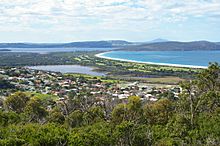Lake Seppings facts for kids
Quick facts for kids Lake Seppings |
|
|---|---|

View of Lake Seppings from Mount Clarence
|
|
| Location | Great Southern region, Western Australia |
| Coordinates | 35°0′48″S 117°54′48″E / 35.01333°S 117.91333°E |
| Type | Permanent freshwater |
| Native name | Tjuirtgellong Error {{native name checker}}: parameter value is malformed (help) |
| Basin countries | Australia |
| Designation | Lake Seppings Nature Reserve |
| Max. length | 1.1 km (0.68 mi) |
| Max. width | 0.4 km (0.25 mi) |
| Shore length1 | 2.7 km (1.7 mi) |
| Settlements | Albany, Western Australia |
| 1 Shore length is not a well-defined measure. | |
Lake Seppings is a freshwater lake located in the city of Albany. This city is in the Great Southern region of Western Australia. The local Noongar people call the lake Tjuirtgellong.
Contents
About Lake Seppings
This beautiful lake is about 3 kilometres (2 mi) east of Albany's city centre. Main roads like Golf Links Road and Troode Street surround it. You can walk almost all the way around the lake on a 2.7-kilometre (1.7 mi) path. This path is made of compacted gravel and wooden walkways.
There is a special wooden bird hide on the western side of the lake. From here, you can quietly watch the many birds. A car park on Golf Links Road makes it easy to access the walking path.
Lake Seppings stretches about 1.1 kilometres (0.7 mi) from north to south. Its widest part, at the northern end, is about 400 metres (1,300 ft) across. The lake gets narrower towards the south. The walking path even crosses the lake near its southern tip. The lake is part of the Lake Seppings nature reserve, which covers 17.1 hectares (42 acres).
Amazing Wildlife at the Lake
Lake Seppings is a fantastic spot for watching birds, especially water-birds. More than 100 different kinds of birds have been seen here!
Birds on the Water's Edge
You can often spot wading birds along the lake's edges. These include the Australian white ibis, with its long curved beak. You might also see the yellow-billed spoonbill and the white-faced heron.
Birds on the Lake Surface
Many birds spend their time floating on the lake's surface. Look for the blue-billed duck and the large musk duck. The elegant black swan is also a common sight. Other birds include the hoary-headed grebe, the huge Australian pelican, and the Eurasian coot.
Birds in the Plants
Some birds prefer to hide among the plants around the lake. Keep an eye out for the spotless crake and the masked lapwing. You might also see the dusky moorhen, the colourful purple swamphen, and the shy buff-banded rail.
Plants Around the Lake
Lake Seppings has a wide variety of plants growing around its edges.
Lakeside Plants
Right next to the water, you'll find tall plants like bullrushes, reeds, and sedges. These plants are important for the lake's ecosystem.
Fringing Trees
The trees around the lake are a mix of different types. You'll see Western Australian peppermint trees and spearwoods. There are also paperbarks, native willows, and wattles. Beautiful Banksia plants also grow here. The northern end of the lake has a thick forest of these trees.
Dealing with Weeds
Some areas, especially on the north-western side, have been cleared. Unfortunately, these areas are now growing many weeds. These include plants like kikuyu grass, bracken, and blackberry. Conservation groups are working hard to fix this. They are clearing the weeds and planting native trees and shrubs. Some of the new plants include bluegums, Albany woolly-bushes, and kangaroo paws.
History of Lake Seppings
Lake Seppings has a long and interesting history.
Ancient Times
About 20,000 years ago, the sea level was much lower than it is today. The coastline was about 4 kilometres (2.5 mi) away from where the lake is now. As the sea level rose, the lake became a shallow part of the ocean floor. This is why you can find old cockle shells in the soil around the lake! Then, about 8,000 years ago, the sea level dropped again. This left Lake Seppings about 500 metres (1,640 ft) from the coast.
Early Protection Efforts
In 1887, people in the Albany Municipal Council suggested protecting the land around Lake Seppings. They wanted to make it a "Commonage" for the town. This meant it would be land used by everyone. In 1888, the lake was officially made a Botanic garden. This meant it was a place for studying and growing plants. In 1900, it was renamed "Albany Park" and protected as a natural wetland.
Restoration and Community Action
From 1900 to 1970, the west side of the lake was used as a rubbish dump. But in 1972, a government department suggested the lake become a reserve for water-birds.
In the 1980s, the Apex club of Albany started building the bird-walk. By 2000, the Albany community strongly demanded that the lake be protected and restored. The walking trail around the lake was finally finished in 2004.
More recently, in 2018, a large community project took place. Volunteers planted 22,000 trees and other plants around the lake. This was to create a "biodiversity urban corridor." It helps to bring back native plants and provide homes for animals like the endangered western ringtail possum.
Dreamtime Story
The local Noongar people have a special name for the lake: Tjuirtgellong. This name means "The place of the long-necked tortoise." The lake is very important to the Noongar people. They believe it is the footprint of a spirit named Djrat. This spirit is said to have created the south coast of Western Australia.
Gallery
Images for kids







